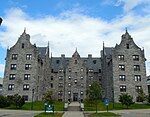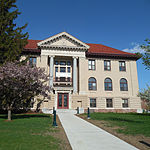Chittenden-3-4 Vermont Representative District, 2002–2012
The Chittenden-3-4 Representative District is a two-member state Representative district in the U.S. state of Vermont. It is one of the 108 one or two member districts into which the state was divided by the redistricting and reapportionment plan developed by the Vermont General Assembly following the 2000 U.S. Census. The plan applies to legislatures elected in 2002, 2004, 2006, 2008, and 2010. A new plan was developed & passed in 2012 following the 2010 Census. The rest of Burlington is represented by the Chittenden-3-1, Chittenden-3-2, Chittenden-3-3, Chittenden-3-5 and Chittenden-3-6 districts. At the time of the 2000 census, the state as a whole had a population of 608,827. As there were a total of 150 Representatives, there were 4,059 residents per representative (or 8,118 residents per two representatives). The two member Chittenden-3-4 District had a population of 8,792 in that same census, 8.3% above the state average.
Excerpt from the Wikipedia article Chittenden-3-4 Vermont Representative District, 2002–2012 (License: CC BY-SA 3.0, Authors).Chittenden-3-4 Vermont Representative District, 2002–2012
Colchester Avenue, Burlington
Geographical coordinates (GPS) Address Phone number Website Nearby Places Show on map
Geographical coordinates (GPS)
| Latitude | Longitude |
|---|---|
| N 44.479166666667 ° | E -73.195833333333 ° |
Address
University of Vermont Medical Center
Colchester Avenue 111
05401 Burlington
Vermont, United States
Open on Google Maps








